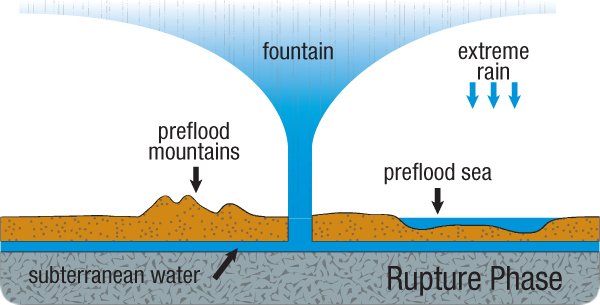
showing what he calls the "Rupture Phase of the Flood"
Part of Kuban's Paluxy Website
Readers who may wish to offer constructive comments or corrections may contact me at gkpaleo "at" yahoo.com.
(I use this format to avoid webbot spamming)

|
|
Fig. 1. Diagram from W. Brown's website and book showing what he calls the "Rupture Phase of the Flood" |
Brown presented early versions of the model during the 1980's (Brown, 1986), and subsequently revised and expanded it into a more comprehensive model of earth history, which he described in a book entitled In the Beginning: Compelling Evidence for Creation and the Flood, now in its 8th edition (Brown, 2008). He provides updates and excerpts of large portions of his book at his Creationscience.com website, where major portions of the upcoming 9th edition can be found. Brown indicates that he is "Director of the Center for Scientific Creation" in Arizona, which apparently consists of two people (he and his wife).
Brown's Flood model and associated claims are overwhelmingly rejected by conventional scientists, since they strongly conflict with many lines of evidence that the Earth and solar system have had a long and complex history, and that the Earth is about 4.6 billion years old (Hazen, 2013; Strahler, 1987). Detailed critiques of Brown's Flood model (based on earlier editions of his book) have been made by Lippard (1989a, 1989b, 1990) and Jellison (2009a, 2009b), while one or more his specific claims have been refuted by others (Bahcall, 2004; Fleming, 2012; Kuban, 1997; Matson, 1995a,b; Morton, 2003a; Sharp, 2005; Van Till, 1986). A point-by-point refutation of many of Brown's claims is found on RationalWiki (2018). Although Brown's Flood model has garnered considerable popularity among lay creationists, many YEC authors and major groups such as AIG and CMI have rejected or strongly questioned it, and refuted many of his specific arguments (Oard, 2013; Faulkner, 2014).
In the wake of such criticisms, Brown removed a few glaring errors from his 2018 book, such as those regarding the "shrinking sun," "missing neutrinos, and a "Japanese plesiosaur" (Kuban, 1997). However, he continues to promote many other dubious and unfounded claims in the draft 9th edition of his book, featured at his website, where he continues to sell the 8th edition (without qualifications), despite a number of contradictions with the 9th edition draft. This review expands on past critiques, and addresses recent updates to Brown's book and web site. Unless otherwise stated, any references to page numbers applies to the 8th edition of his book.
Even without earthquakes or meteorite impacts, the only way a surface crust could cover a global expanse of water below it is if it were almost perfectly smooth, lacking any mountains even hills. Otherwise the crust would buckle, massively fracture, and release the subterranean waters (Morton, 2003a). Since Brown accepts the presence of pre-Flood mountains (which are mentioned in the Bible), Brown evidently realized that he needed something to help support the crust. Thus, he proposes that on Days 2 and 3 of the "creation week" (which he takes as literal solar days), the granite crust "sagged down" deeply in places, all the way to the floor of the rock below the water chambers, forming supporting "pillars." However, this only exchanges one set of problems for another. First, there is no empirical evidence for such pillars. Second, miles-thick granite plates would not "sag" and deform, especially in a matter of days, without extensive and massive cracking, which would immediately release the pressurized water. Brown suggests the granite crust would act like "putty" while under pressure, allowing it to deform without much cracking, and that any cracks would self-seal before they reached the water chambers. However, granite is an extremely hard and crystalline type of rock, and does not deform to any significant degree without massive fracturing, except when near its melting point, and over long time periods (Nelson, 2012). In contrast, Brown suggests the pillars formed in days, and if the Earth was hot enough to melt granite during the "creation week," it would only exacerbate the already immense heat problems discussed below, and kill all life on earth.
For years Brown held that the granite "hydroplates" were 10 miles thick, even though no evidence supported that assumption, and despite extensive geologic evidence indicating that the Earth's crust ranges from 20 to 60 miles thick. Although the current (8th edition) of Brown's book still includes the 10 mi. figure, he recently modified his website to indicate that the pre-Flood crust varied from place to place, and was between 20 to 60 miles thick. While this allows one facet of his model to better coincide with geologic data, it exacerbates the problems discussed above. First, it worsens the irregularities that would invite cracks in the crust. Second, the greater thickness of the granite crust would make it even more difficult to deform severely and form the "pillars" without extensive cracking and earthquakes, immediately releasing the pressurized water below.

|
Even more energy and heat would have been involved if one includes in the calculations the energy needed to launch all the material to explain all the other comets, asteroids, and meteoroids that have impacted on various planets and moons of our solar system (as evidenced by many millions of craters on many of them), and others that impacted the sun and gaseous planets, or escaped into outer space. Even YEC author Danny Faulkner (2013) of AIG demonstrated that the heat involved in the eruption phase alone would have been many times beyond lethal to all life on earth. In a video at his home page, and in the on-line draft of his 9th edition, Brown himself states that the energy released during the hydroplate eruptions would have exceeded 300 trillion atomic bombs (Brown, 2016). This makes it even more implausible that Noah and his cargo, or any macroscopic life on earth for that matter, would have survived the proposed hydroplate eruptions, to say nothing of the additional sources of massive heat and violence discussed below.
In his reviews of Brown's book at Amazon.com, physicist Gerard Jellison calculated that the mass of particles and water vapor expelled from earth in order to explain the comets, asteroids, and meteoroids in our solar system would be over 100 times greater than the Earth's mass (Jellison, 2009a). He further calculated that if only 0.001% of the mass and energy of the eruptions wound up in the Earth's atmosphere, the atmosphere would have been raised by 3000 degrees F! Of course, Jellison was being very generous to Brown, since even leaving only 1% of the heat on earth would be thoroughly untenable. After all, Brown's theory holds that many cubic miles of super-hot, sediment laden water gushed through miles more of solid rock, then entire oceans, then miles more atmosphere. Even if his proposed forces allowed that, they could not occur without huge amounts of friction, turbulence, and steam release, and condensation on Earth--all involving massive amounts of energy and heat left on Earth. Indeed, according to Brown's own descriptions, diagrams, and videos, the eruptions or "jets" did not shoot up in tight vertical spouts or planes (even if they did, massive friction and steam release would occur), but spewed out violently both upward and outward as violent "fountains," with a lot of water and debris falling back to earth as "extreme rain." Meanwhile, also based on Brown's own descriptions, after the initial "rupture phase" the subsequent "undulating", "crashing", "sinking", and "sliding" of continent-sized hydroplates would have produced enormous amounts of heat and friction as continent sized plates sped across the entire planet within weeks, and entire mountains were pushed up in "hours." Still more heat, which Brown himself calls "massive" would have been produced from widespread volcanic activity and magma outpourings during these events. In view of all this, the energy and heat left on earth would be orders of magnitude more than 0.001%, which again, would be more than lethal to all life on earth.
Yet another heat problem in Brown's model concerns the mixing of the surface oceans with the super-hot waters in the subterranean chambers. Brown indicates that due to nuclear decay and "tidal pumping," the subterranean waters become immensely hot and pressurized, and took on special properties to become "supercritical water" (SCW). Taking into account the temperatures needed to produce objects called chondrules in meteorites, which he believes came from Earth, he suggests that the temperature of the "SCW" water reached over 1300 deg F. He also states that the volume of the water in the lower chambers was about the same as the oceans above. The problem is, if the lower and upper waters mixed even a small amount during the Flood, which would have been inevitable, the oceans would have turned into boiling caldrons, killing virtually all sea life. Even aside from the "extreme rains," (Brown's own term), significant mixing of the waters had to occur in order to accommodate several aspects of Brown's model, including supposed widespread "liquefaction" (discussed further below) and his proposed mechanisms for the formation of salt domes, limestones, mesas, and other geologic phenomena. Brown states, "As the SCW jets up into the cold sea water and cools, hydrocarbons quickly precipitate, paving the seafloor with a tar residue." Even setting aside the fact that the sea floors are not covered with tar, the processes he describes involve water temperature changes of hundreds of degrees, which would of course be more than fatal to most sea life.
In his 9th edition draft Brown seems to further exacerbate the already immense heat problems in his model by proposing that the subterranean waters acquired extreme amounts of heat through deutrium fusion (a nuclear reaction). He suggests that the amount of nuclear energy added to the subterranean water over several weeks by forming deuterium was equal to "the energy released by 1,800 trillion 1-megaton hydrogen bombs!" To grasp the enormity of that number, note that the entire volume of the Earth's oceans is about 1.3 billion cubic kilometers (Gleik, 2006). If my math is right, that means that if even 1% of the proposed energy were left on Earth (still very generous to Brown), it would still leave the equivalent of almost 14 H-bombs for every cubic kilometer of sea water! Apparently seeing no problem with that (even though it would be enough to vaporize the oceans many times over), Brown suggests that the "1,800 trillion" figure is a "conservative estimate," because "other products of nuclear fission and decay would have added additional energy, and some water was expelled permanently from earth." (Brown, 2017, endnote 89, p. 425). Elsewhere Brown tries to remove or counteract some of this energy through other esoteric nuclear processes. However, the proposed nullifying processes seem questionable at best (discussed under the "Radiometric Dating" section below), and the magnitude of the initial nuclear energy alone seems extremely problematic, to say the least.
The proposed hydroplate eruptions and volcanic eruptions would also have launched enormous quantities of aerosols and fine sediment into the atmosphere, leaving it heavily contaminated and largely opaque, on top of top of already catastrophic climate changes and habitat destruction. Jellison (2009a) remarks: "Brown never explains how the already stressed, genetically depleted organisms from the Ark could have dealt with the resulting climate changes and loss of photosynthesis."
Meanwhile, according to Brown, huge masses of dissolved salt and calcium would have been released from subterranean deposits, and within days, formed the many salt domes and limestone deposits on earth. It's inconceivable how most ocean creatures could have survived these sudden and massive environmental onslaughts, especially since many are adapted to narrow ranges of salinity, acidity, turbidity, and other conditions. Of course, these problems are admittedly largely moot in view of the multiple sources of lethal heat in Brown's model (the most severe of which has yet to be mentioned).
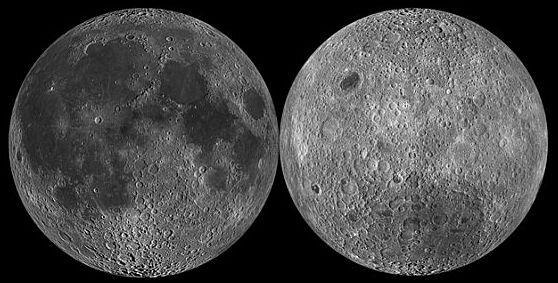
|
| Fig. 3. Near site (left) and far side (right) of the Moon. Credit: NASA. |
Attempting to bolster his claim that meteoroids, asteroids, and comets originated from Earth, Brown describes them all as "earth like" in composition. However, their composition is quite variable. For example, many meteorites contain large portions of iron and nickel, which does not match the proposed composition of Brown's hydroplates (mostly granite), nor the known composition of most of the Earth's crust. Brown tries to account for iron-rich meteorites by proposing that they came from the lower parts of the water chambers, where heavier metals sank before the hydroplates erupted, but overall meteorites have compositions considerably different from earth rocks (Korotev, 2015). For example, one of the major rock types on earth is limestone (and its metamorphosed form, marble) which are not found in comets, meteorites, or asteroids, except as small traces. Moreover, such traces are in inorganic forms, whereas most earthly limestones (discussed below) are largely composed of organic remains.
Another line of evidence against Brown's claims about the earthly origin of asteroids is that, as Sharp (2005) notes, "We can calculate the motions of the asteroids back in time, and find no evidence at all that they originated from the Earth, or the vicinity of the Earth's orbit, a few thousand years ago. Indeed, their orbits correspond to them being in existence in many cases for billions of years, as determined from long term stability calculations taking account of the perturbations of the planets..." Brown's astronomical claims are also contradicted by the Baptistina asteroid family, which have similar orbits and evidently were produced by an ancient collision of two large asteroids. By tracing the orbits of the resulting asteroids back in time, augmented with data from the Wide-field Infrared Survey Explorer, astrophysicists have calculated that the original collision occurred about 80 million years ago (Rationalwiki, 2012).
Moreover, as mentioned earlier, meteorites and impact craters found in Precambrian strata (Gilkson, 2013; Matson, 1995c) also refute Brown's claims about the earthly origin or meteoroids and asteroids, since Brown implies that Precambrian rocks are pre-Flood.
Brown suggests that the near side of the Moon received far more and larger impacts than the far side, implying the objects that made them originated on earth. However, photos of the far side show even more craters than the near side. Brown acknowledges that the near side is "smoother," but attributes this to volcanism (as do conventional scientists) caused by a greater number of impacts. In any case, the far side is clearly heavily cratered, even though his model predicts it should be largely devoid of impacts. Brown suggests they were the result of material kicked up by the impacts on the near side, and as support he suggests most craters on the far side are small. However, the craters there exhibit size ranges similar to those on the near side, and include many large craters. In fact, it contains the largest crater on the moon, and one of the largest in the Solar System: the South Pole-Aitken basin (Dutch, 2009).
This brings up another point, which is that Brown seems to have a major geometric problem with his thesis about the origin of comets, meteorites, and asteroids. That is, even if the ejections were somehow aimed largely at the planetary orbit plane (which seems untenable, considering the orbits and rotations of the Earth and other bodies), most of the ejected material would miss them, due to the vast spaces between the bodies (even giving due consideration for gravitational forces). Yet all planets and moons of our solar system capable of recording craters are densely covered in them. Even if many of the smaller craters were due to secondary impacts from material falling back from larger impacts, if one considers only the larger impacts, and extrapolates to estimate the immense number of asteroids and comets that must have missed the bodies, the volume of the ejected material would be many times the volume of the entire Earth!
While attempting to refute the "Big Bang" model of the origin of the universe, Brown cites the work of William G. Tifft (1991) on "redshift quantization." Brown states, "If redshifts are from objects moving away from Earth, one would expect redshifts to have continuous values. Instead, redshifts tend to cluster at specific, evenly-spaced values." However, more recent and precise surveys of quasars have produced no evidence of quantization in excess of that expected from galaxy clustering (Tang, 2005), leading the vast majority of cosmologists to reject the concept of redshift quantization.
Brown argues that most sedimentary rocks were derived from the eroded granite hydroplates, along with deposits of calcium and salt deposits which he says accumulated in the subterranean chambers before being released during the Flood. Thus, we should expect most of the Earth's sedimentary strata would be made largely of eroded granite, along with deposits of salt and inorganic calcium. Brown states that the sedimentary strata of the Earth are "typically parallel, thin, uniform in thickness, vast in area.... " and asks, "Why are strata so uniform in hardness?" Actually, rock strata are far from uniform in hardness, thickness, composition, or geographic extent. Even in one outcrop they can vary from very soft and friable layers to incredibly hard beds. Strata also very greatly in grain size, type, and distribution, and many other features, precisely because they were deposited in many different environments and in many different ways. Extensive evidence indicates that most limestone deposits are not produced by rapid precipitation of inorganic calcium, but gradual accumulation of organic material (discussed further below). Throughout much of the geologic record we even find many "paleosols" (ancient soil beds) which are incompatible with Brown's model.
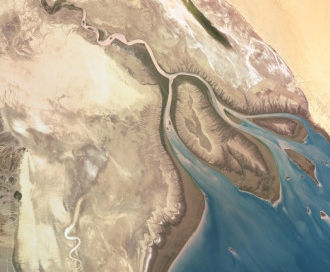
|
| Fig. 4. Colorado River Delta seen from space. Isla Montague is the large island in the center. Credit: Wikipedia (2004). |
1. Publishing status. Brown has not published these new proposals in rigorous scientific papers, even in the creationist press.
2. Undemonstrated extrapolations. Brown evidently bases his new ideas largely on anecdotal accounts of unusual forms of
lightning and other atmospheric observations,
along with highly specialized lab experiments involving small-scale phenomena. He has not shown with calculations or other
rigorous data that these phenomena would apply in subterranean water chambers during a global Flood, let alone at
the precise levels needed to explain the amount and patterns of nuclear decay in the geologic record.
3. Lethal radiation. Even if the proposed mechanisms generated the needed accelerated decay rates, the massive radiation levels they
generated would be more than lethal to humans and most other life forms (Fleming, 2012).
4. Lethal heat. Vastly accelerated nuclear decay would also generate lethal levels of heat, greatly exacerbating the already
deadly heat from other aspects of Brown's model. Meert (2002) states, "Radioactive decay at a rate fast enough to
permit a young earth would have produced enough heat to melt the Earth." Brown has denied this, and recently argued that certain isotopes
created by the p. effect would absorb a lot of the heat. But again, he has not rigorously demonstrated that his
mechanisms would apply during a Flood, or generate the specific decay rates he needs, let alone eliminate the heat problem.
5.C14 dates unexplained. Apparently his proposed mechanisms would not apply to atmospheric carbon, and thus not explain C14 dating results.
6. Deepest rock dates unexplained. His mechanisms would be expected to affect sediments involved in the Flood, but largely exclude
deep Precambrian strata, even though they yield the oldest radiometric dates.
7. Sloping patterns. None of his mechanisms explain the overall, slopping patterns of radiometric dates from stratigraphically
lowest to highest rocks, since his model holds that almost all sedimentary rocks were generated within a single year, meaning that even the oldest
and youngest rocks would be separated by at most 6,000 years. Yet the slopping patterns do exist, and are well documented for several different
dating methods.
8. Conflicting dates from meteorites. Most yield radiometric ages from 4.5 to 4.6 billion years BP (Krot, 2002; Krot et al, 2002; USGS, 2009),
rather than showing a much wider range similar to earth rocks, even though Brown asserts they were all ejected from earth at the time of the Flood (the
early stage of the Flood), and that they are made from the same materials.
9. Conflicting dates from the Moon and Mars. Rocks from these bodies have been radiometrically dated from 3.0 - 4.5 billion years
(Farley et al, 2013). If Brown believes all of the dated rocks came from earth (which is not clear), the same problem apples as in number 8
above. If he accepts that some did not come from earth, then his mechanisms cannot account for these old dates, unless he envisions hydroplate
floods on the Moon and Mars.
10. Several idependent radiometric dating methods give larvely consistent results indicating that the Earth is approximately 4.6 billion years
old. These results are further corroborated by other, non-radiometric dating methods (Dalrymple, 1991, 2000, 2006; Strahler, 1987; Young, 2008).
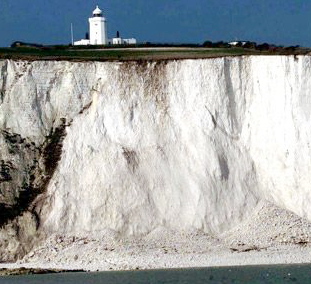
|
| Fig. 5. White Cliffs of Dover, England |

|
| Fig. 6. Microfossils in Cretaceous limestone |
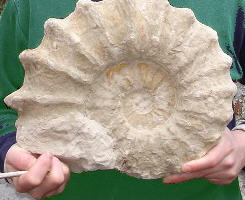
|
| Fig. 7. Ammonite from White Cliffs of Dover |
Brown claims that "liquefaction" during the Flood explains "fossil layering". However, it is not even clear how liquefaction could be very applicable to his model, let alone explain fossil succession. In geologic usage, liquefaction normally refers to damp, sandy rock or soil becoming fluid-like during earthquakes. In contrast, a large portion of fossils occur in shales, limestone, dolomite, ash beds, clay, and other sediment types which were clearly not produced by liquefaction. Also, since Brown claims that most sediments were eroded at hydroplate edges, the sediments would already be under water and unconsolidated, and thus not involve liquefaction.
Brown describes another experiment, conducted by Loma Linda University (which holds to YEC views), where a dead amphibian, reptile, mammal, and bird were placed into an open water tank. Brown reports that "the natural order of settling following death was, from the bottom up, amphibian, reptile, mammal, and finally, bird", suggesting that this essentially matched the order of fossils in the geologic record. There are several problems with this experiment. First, it was not published in any scientific journal, but was simply an anecdotal account, lacking in many details. We are not told what specific animals were chosen, whether they all died at the same time (which would relate to decomposition and bloating), what if any sediment was in the tank. Brown mentions "buoyancy" and settling from bottom to top, implying they recorded the order in which the animals floated to the surface. But if so, it would be largely irrelevant to the order in which they would be buried and preserved as fossils. Second, each of these groups includes thousands of different species of many different sizes, shapes, etc., so depending on which species and individuals (young vs. old, etc.) were chosen, one could get almost any results, including an order opposite the one reported. Third, even if the results consistently showed the same order, they would not be a good representation of the actual fossil record. For example, amphibians do not appear in the lowermost sediments, nor are they confined to the period in which they first appear in (Devonian). They occur in every subsequent period as well, in different forms. Granted, this would not even be possible to show in the experiment, since only one specimen for each animal group was included, which is another problem with it. The important point is that in the fossil record, different types of organisms appear in different periods, with the oldest (stratigraphically lowest) species generally the most different from modern ones. This is consistent with evolution, not the Loma Linda experiment or Brown's model, or his apparatus results. This applies not only to the four types of vertebrates used in the Loma Linda tank, but also fish and countless invertebrates, which the Loma Linda team did not include in the tank, even though they are more common as fossils than the groups they included.
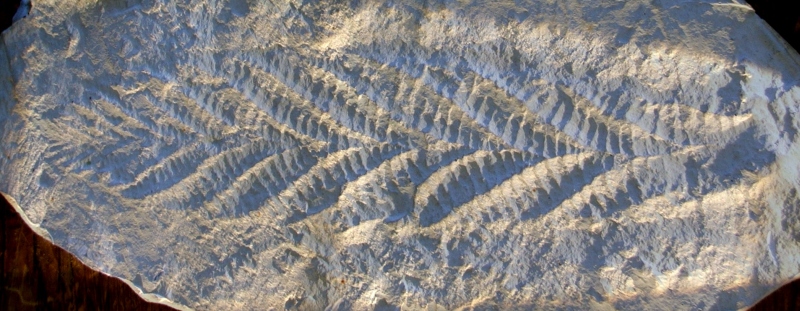
|
|
Charnia masoni, an Ediacaran lifeform from England, believed to be an early filter-feeding marine organism. |
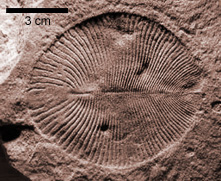
|
|
Dickinsonia from Ediacara Hills (Vendian rocks) of southern Australia. It is thought to be a possible early relative of corals. |
| Fig. 8. These Precambrian fossils are among those Walt Brown implies do not exist. |
Brown states: "The 'evolutionary tree' has no trunk. In what evolutionists call the earliest part of the fossil record (generally the lowest sedimentary layers of Cambrian rock), life appears suddenly, full-blown, complex, diversified, and dispersed worldwide. Evolution predicts that minor variations should slowly accumulate, eventually becoming major categories of organisms. Instead, the opposite is found. Almost all of today's plant and animal phyla including flowering plants, vascular plants, and vertebrates appear at the base of the fossil record. In fact, many more phyla are found in the Cambrian than exist today. Complex species, such as fish, worms, corals, trilobites, jellyfish, sponges, mollusks, and brachiopods appear suddenly, with no sign anywhere on earth of gradual development from simpler forms. Insects, a class comprising four-fifths of all known animal species (living and extinct), have no known evolutionary ancestors. Insects and other arthropods found in amber, supposedly 100-230 million-years-old, look like those living today. The fossil record does not support evolution.
In this one paragraph Brown manages to make several false and misleading claims. First, contrary to Brown's suggestion, the earliest fossils are not found in the lower Cambrian, but in the Precambrian. Many indisputable Precambrian fossils are known, including stromatolites (matted algal & bacterial structures), and a large variety of soft-bodied forms and trace fossils from several locations, dated between 542 and 635 million years (Fig. 8). These soft-bodied fossils are often referred to as Ediacaran or Vendian biota (Fortey, 1999; Hazen, 2013). Although their taxonomic status is debated, some may be forerunners of known phyla, but are not readily identified with any extant orders or classes, let alone modern species. Likewise, Brown's comment about "Complex species, such as fish, worms, corals... " appearing in the lowest beds is similarly misleading. These entities are not "species" but much larger taxonomic groups--at the Class or higher taxonomic level. This is critical, because by using this linguistic sleight of hand, Brown gives the impression that many modern species occur at the lowest levels of the fossil record, when in fact none do. Even most extant genera and families are not found in either the Precambrian or Cambrian, nor even in the rest of the Paleozoic. However, as one progresses up the fossil record, more modern families and then genera begin to appear, and finally, in the upper most strata, more genera and species appear more like modern ones. This well documented pattern of "fossil succession", discussed in more detail later, which holds for all groups of plants and animals, is strong support for evolution. Brown can only state the opposite conclusion by obscuring the actual fossil evidence.
Brown's remarks about flowering plants and vertebrates (animals with backbones) likewise foster the impression that many modern species of plants, fish, amphibians, reptiles, mammals appear at the start of the fossil record, whereas in reality, none do. Not only do no modern angiosperm or vertebrate species appear anywhere in the Precambrian or even Cambrian (although in the YEC paradigm, one would expect to find many there), we don't even find any extant classes, families or genera of these groups in either time period. The earliest flowering plants do not appear until the Mesozoic Era. The earliest amphibian-like animals occur in the Devonian; the earliest reptile-like animals in the Pennsylvanian; the first mammal-like reptiles in the Permian, and the first true mammals in the Cretaceous. Even when mammals appear, they do not include any large modern ones, even though again, by the YEC paradigm, they should. All of this supports evolution, and starkly contradicts the picture Brown paints.
Brown claims that there is no sign that any of the groups he mentions show an origin in "simpler" forms is also misleading. Whether "simpler" or not, each of the groups he mentions shows fossil evidence of intermediate forms.
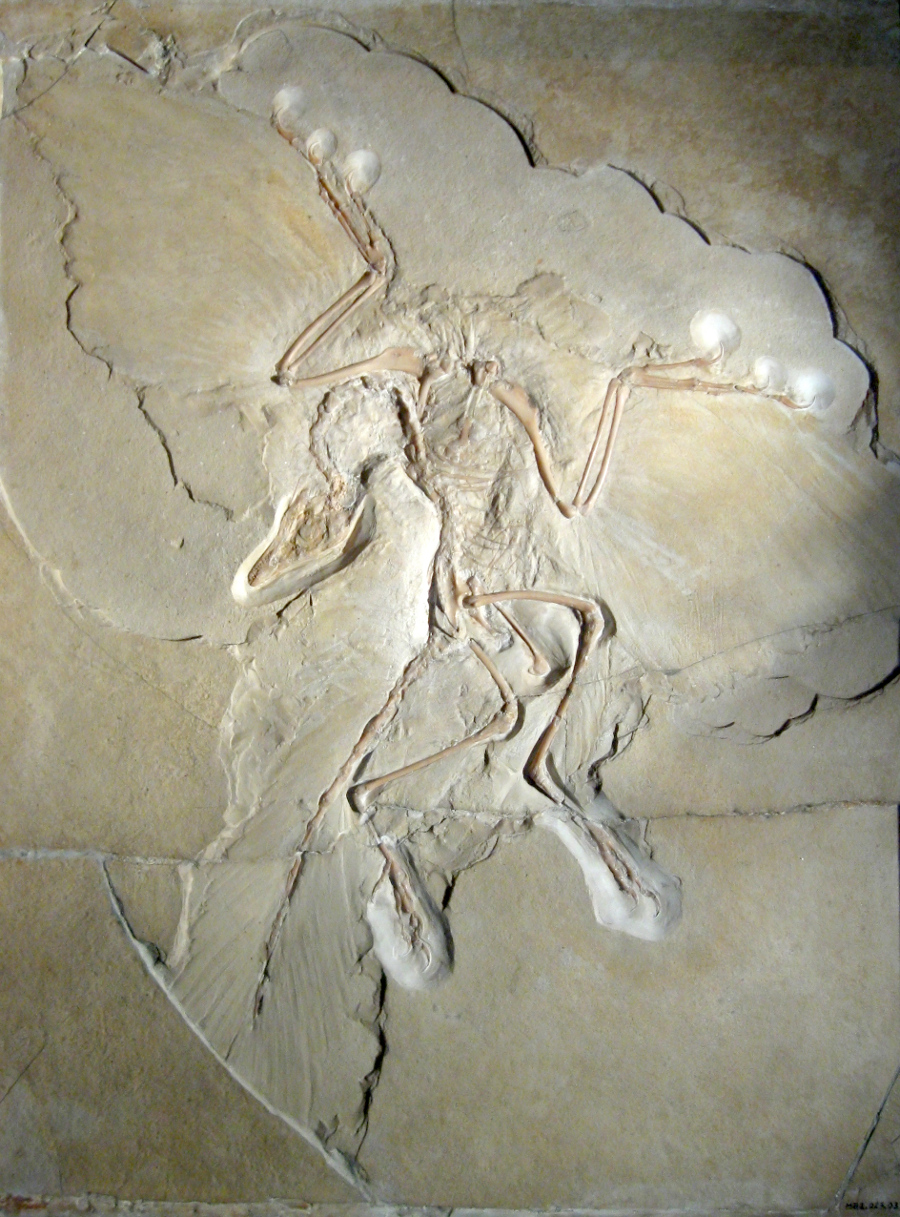
| |
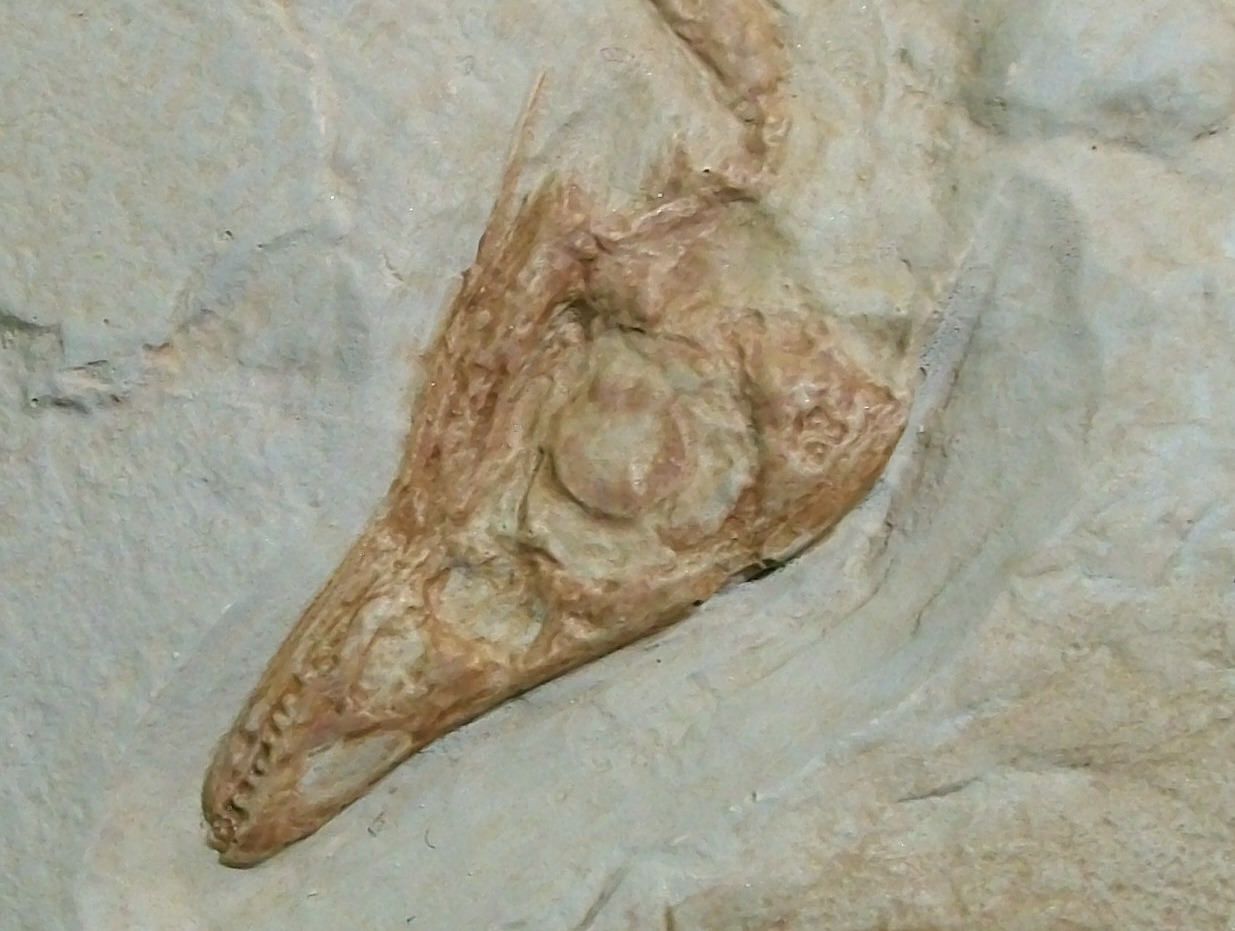 |
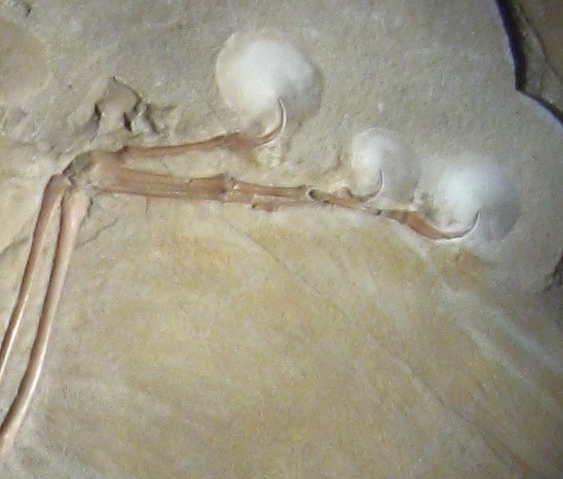 |
| Fig. 9.
Archaeopteryx (Berlin specimen) showing feathered wings, as well as claws on the forelimbs, teeth, and a long, bony tail. Several other Archaeopteryx specimens also show feather impressions. | |

| |
| Fig. 9b. Compsognathus vs Archaeopteryx vs Modern bird (chicken) |
Brown incorrectly implies that except for the feather impressions, these fossils would be identical to the small theropod dinosaur Compsognathus. However, his cited source merely states that Archaeopteryx closely resembles small theropods "such as" Compsognathus, not that they are identical. Indeed, despite their similarities the two genera exhibit a number of clear differences (Fig. 9b). For example, Compsognathus has far shorter fore limbs, almost twice as many vertebrae in its tail (40 vs 23), and prominent haemal arches (bony processes extending off its tail vertebrae), which Archaeopteryx lacks. Even most YECs reject the claim that Archaeopteryx is a fraud, but also reject it's transitional status. Ironically, most YECs argue that Archaeopteryx is 100% bird, whereas Brown argues that it is 100% dinosaur. In reality, it shows many features of both. The reptilian features include teeth in the jaw, lack of a horny beak, claws on the forelimbs, and a long, boby tail with unfused vertebrae; the avian features include a full set of flight and tail feathers, and largely opposable halluxes.
Brown asks how the leap from land animals to whales could have been made, but does not discuss the many fossils that shed considerable light on this transition (Babinski, 2015; Perrin et al, 2009; Thewissen, 1998, 2014). Brown also does not mention that even some modern whales, especially Right Whales, show vestigial hind limbs (Gingerich et al, 1990, 1994).
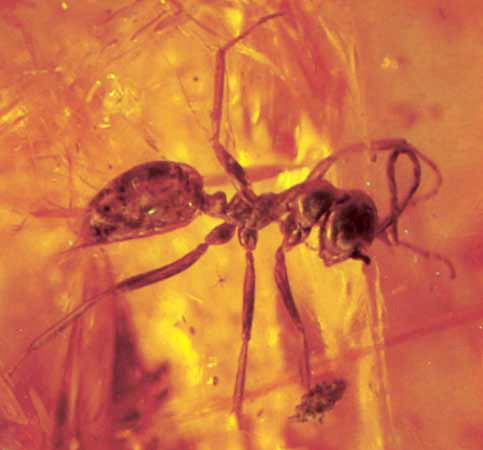
|
|
Fig. 10. Sphecomyrma freyi in Cretaceous amber, showing features intermediate between wasps and ants |
Brown implies no intermediates are known between fish and amphibians, ignoring a number of classic examples, including Tiktaalik, which shows a variety of features intermediate between these two groups (Daeschler et al, 2006).
Brown insists no transitional forms have been found in amber (fossilized tree resin). Ironically, however, one of the most impressive intermediate fossils was an insect found in 1966 in Cretaceous amber in New Jersey (Fig. 10). Assigned to a new genus, Sphecomyrma, it showed intermediate features between wasps and ants. Since then other specimens of Sphecomyrma have been found, two of which have been assigned to new species, and also show intermediate features (Simmons, 1997). Another intermediate insect in amber is the earliest known myrmecophile (ant-loving) rover beetle from the early Eocene of India. It shows a number of primitive features, including distinct abdominal tergites, which are fused in modern Clavigertites (Parker and Grimaldi, 2014).
One of the groups with a number of compelling intermediates is primates. Indeed, fossil hominids show such a range of intermediate forms that despite YEC insistence that all are either "just apes" or "fully human", Brown and other YECs can't seem to make up their mind on which are which (our next topic). For many more examples of intermediate fossils, see "List of Transitional Fossils" at Wikipedia (2015), and "Transitional Fossils" at RationalWiki (2015).

|
| Fig. 11. Homo habilis skull KNM-ER-1813 |
Brown cites a paper suggesting that Homo habilis (Fig. 11) should never have been classified in the genus Homo, implying that it too was merely an ape, even though its remains are often associated with stone tools, and a number of other YECs argue that it was probably "human." In fact, like H. erectus and other hominids, it exhibits intermediate features, as the same author acknowledges, whatever the taxonomic and nomenclature issues. True to form, Brown implies that all Australopithecus species (including A. afarensis -"Lucy") were merely apes, citing an author who concluded that some Australopithecines could swing from trees. However, Brown did not clarify that the same author concluded (as have many others) that Lucy and most other Australopithecines could also walk bipedally, even if not as efficiently as modern humans (as would be expected for an intermediate form).
In a thorough review of Brown's hominid claims, Jim Foley (2002) showed that virtually every statement by Brown on the subject is erroneous or misleading. He also noted that some of the strongest evidence for human evolution, such as ER 3733 (a Homo ergaster specimen) and WT 15000 ("Turkana boy") were not even addressed by Brown (Foley, 2002). Foley mentioned that despite Brown's professed eagerness to debate evolutionists, when he invited Brown to respond to his critiques, Brown declined (Foley, 2004, 2004b). For a summary of key hominid finds, many which are ignored or mischaracterized by Brown, see Foley (2011).
Brown and other YECs also have a major problem accounting for the sheer volume of coal on earth. According to Ricklefs (1993), there are 1.16 x 1013 metric tons of known coal reserves, and at least 100 times that much unrecoverable organic matter in sediments. A typical forest, even if it covered the entire earth, would supply only 1.9 x 1013 metric tons. And most coal is clearly made of particular type of plants, and most occurs in Paleozoic and Mesozoic strata, which Brown and most other YECs consider Flood deposits. In short, the amount of coal on earth is far too large to have existed at the time of the Flood, and therefore most have grown and accumulated over long periods of time.
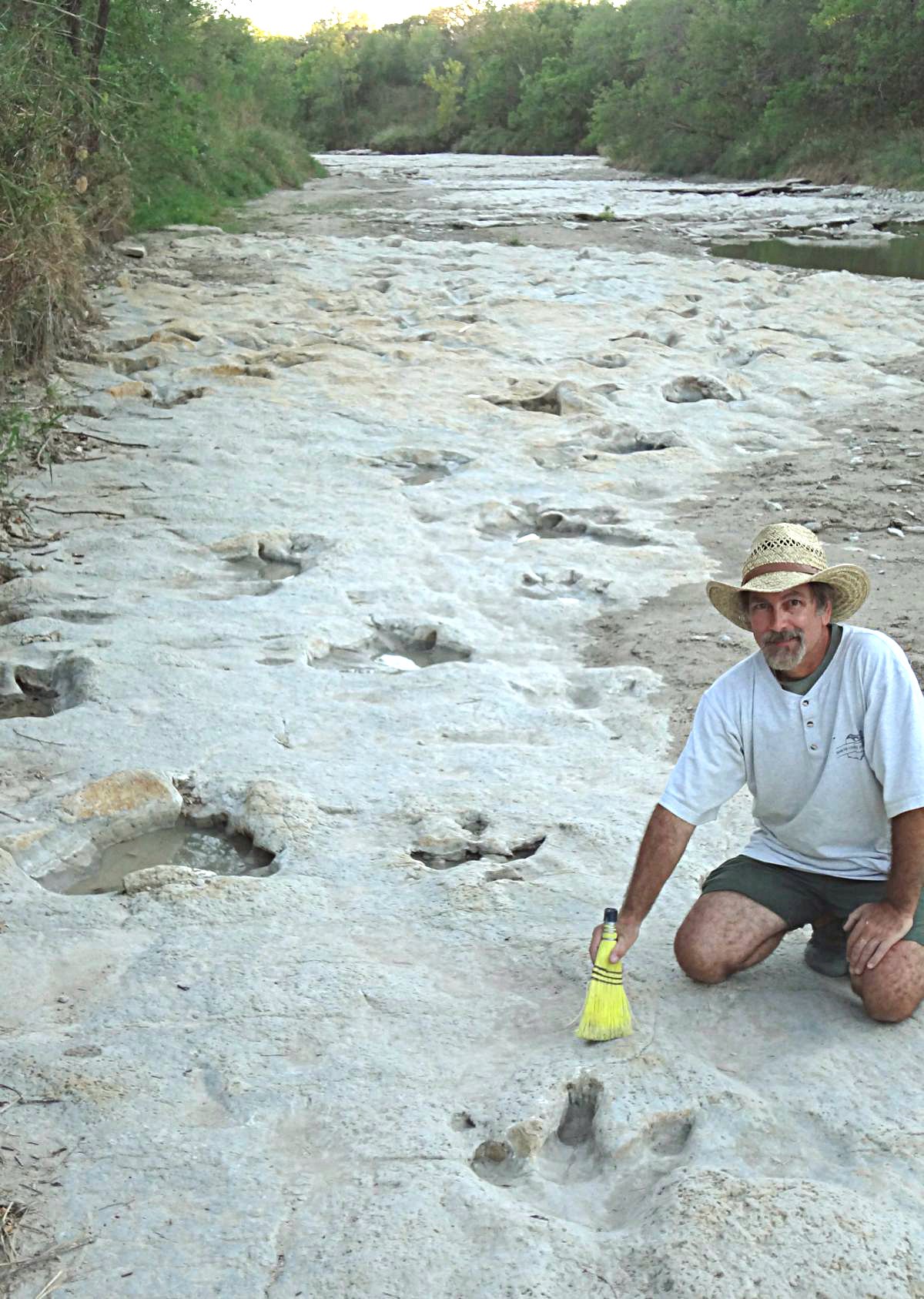
|
|
Fig. 12. Sauropod and theropod dinosaur tracks, in Cretaceous Limestone, Glen Rose, Texas. Many additional layers of fossiliferous or track-bearing limestone occur above and below the picture bed. © 2006, Glen J. Kuban |
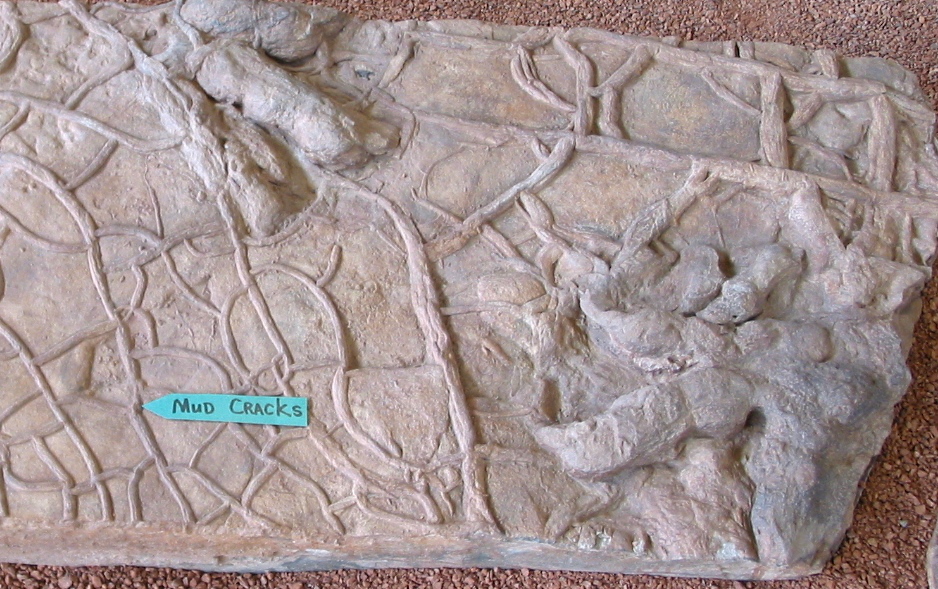
|
|
Fig. 13. Theropod dinosaur tracks crossing mud cracks Lower Jurassic, St. George, Utah |
|
Clearly the tracks shown in the photos above as well as many others at these and other sites, were not formed in the ways Brown suggests. |
Brown also cannot explain how many such limestones (and other geologic formations supposedly deposited during the Flood) contain thousands of dinosaur tracks (Fig. 12) and other vertebrate trackways, and in many cases, extensive invertebrate burrows (sometimes millions on one surface), as well as numerous surfaces with mud cracks. All of these phenomena are indicators of relatively calm, low-energy, shallow water or dry environments which dramatically contradict Brown's violent Flood scenario (Kuban, 2006a; Morton, 2003b). Even more problematic are vast dinosaur nesting sites, which obviously could not form during a violent global Flood (Carpenter, 1999; Chiappe and Dingus, 2001).
Brown suggests that fossil tracks, ripples, burrows, etc. would be preserved if liquefaction stopped at the boundary of "lenses" where they might occur, without explaining why the liquefaction would conveniently stop at footprint surfaces. Even more problematic is the question of how dinosaurs and other creatures would be walking around during the midst of a violent global flood, let alone mating, building nests, and laying eggs. Brown suggests that salamanders might have swum to the top of a "lens" of sediment to make tracks on its surface, while (if I understand Brown correctly) still underwater and surrounded by sediment. However, this imaginative scenario doesn't work for countless dinosaurs and other land animals, even for tracks let alone nesting sites. Of course, it's not plausible for salamanders either, since the conditions are far from those realistically needed for track formation and preservation (Kuban, 1994), even if the animals somehow survived the lethal conditions discussed earlier. The fact that many vertebrate trackways also cross mud cracks (Fig. 13) and even raindrops in some cases (indicating exposed sediments) further refutes Brown's claims about fossil tracks.
This situation is a serious problem for Brown and other YECs, since according to their view, all organisms were living at the same time before the Flood, and therefore many should have been buried and preserved together, or at least at the same stratigraphic horizons. Again, any hydrologic sorting would not help, but foster the comingling of modern and ancient forms in the fossil record. Other YEC proposals for explaining fossil succession, elsewhere encouraged by Brown, such as ecological zonation and differential escape abilities, fare no better, and in some cases also make the matter worse (Strahler, 1987). For example, differential escape abilities cannot begin to explain fossil succession for plants (which of course cannot run for higher ground), and many ancient marine animals had extensive and overlapping habitats (many swimming or drifting widely throughout the ocean), yet are not found together as fossils. If YECism were true, countless thousands of "out of place" (OOP) fossils would be readily found and well documented. Brown asserts that fossils are "frequently" not found in the expected order, but the examples he offers range from poorly founded to well refuted, and are not endorsed by any major creationist groups.
Brown states that human-like and dinosaur tracks have been found in Arizona, and a supposed "shoe print" with trilobites in Utah. However, the Arizona markings are lacking in any distinct human features, and appear to be merely inorganic structures, or in some cases, severely eroded dinosaur tracks (Kuban, 2007). They are even less convincing than the supposed Paluxy "man tracks" which most YECs abandoned in the 1980's after rigorous refutations were published (Kuban, 1986a, 1986b; Hastings, 1987b, 1988). The alleged "shoe print" from Utah, sometimes called the Meister print or a "sandal print," has also been well refuted, and rejected even by most creationists. Upon close inspection it appears to be merely an iron concretion which happened to spall in a manner creating an oblong shape. The "heel" is part of a crack, and the alleged print was not part of a bedding plane, nor in any striding sequence (Kuban, 2011). Brown mentions that similar putative tracks have been found in the area, without clarifying that they too show no convincing evidence of being real human footprints.
Brown claims that 86 consecutive "horse" prints were found in dinosaur age rocks in Uzbekistan, citing the Moscow Pravda (hardly a reliable scientific publication), without any photographic evidence or corroborating scientific reports.
Brown asserts that a Science News article reported that dinosaur tracks and "hoofprints [sic] of some other animal" were found in Virginia. Brown seems to imply that the latter are out-of-place (OOP) mammal prints. However, the popular-level article, which discussed a large Triassic tracksite near Culpeper, VA with hundreds of dinosaur and reptile tracks, used the term "hoof-shaped" only loosely to refer to some indistinct quadruped reptile prints. When better preserved tracks of the same type were later documented at the site, they were more precisely identified as probable tracks of aetosaurs - Triassic reptiles that resembled heavily armored crocodiles (Weems, 1993; Weishample and Young, 1996; Lucas and Heckert, 2011). I personally worked on the site with USGS geologist Robert Weems, and can testify that no anomalous "hoof" prints occurred there (as can many others who worked or visited there). Even after being informed by Jellison (2009) of the above information, Brown kept the VA hoofprint claims in the 8th edition of the on-line version of his book, but finally removed them from a draft of the 9th edition at his website.
Brown suggests that "human-like footprints" have been found with dinosaur tracks in Turkmenistan, but no tracks closely resembling human tracks have been documented at the site. Even if some human-like prints occurred there, it would mean little unless they showed distinct human features, since it is known that elongate, metatarsal dinosaur tracks can sometimes resemble human tracks when their digits are infilled or poorly preserved (Kuban, 1989). The only tracks reported by scientists who worked at the site, and the thousands of tourists who also visited it, are dinosaur tracks. Some are elongate, but show indications of dinosaurian digits (Lockley, 2006; Lockley et al, 1996; Kuban, 2008a). The Geoscience Research Institute, a YEC organization at Loma Linda University in California, states "There have been unsubstantiated reports of human and dinosaur tracks in the same place, but none of them has been confirmed." (GRI, 2015).
Brown asserts that "humanlike" tracks also occur in Paleozoic rocks in Kentucky, Missouri, and "possibly Pennsylvania" without mentioning that these often show very unnatural and stylized shapes (some with four or six toes), are typically not in striding trails, and occur in areas where Indiana petroglyphs are common (Kuban, 2005). Brown suggests that only evolutionary bias would lead one to question any of these supposed human footprints, which is dispelled by the above points, as well as the fact that none are endorsed by any major creationist groups.
Brown claims that bones of "modern-looking" human remains have been found in strata formed "long before man supposedly began to evolve". As support he lists the Calaveras Skull, Castenedolo Skull, Reck's Skeleton, Swanscombe Skull, Steinheim Skull, and Vertesszollos fossils, noting that these finds are "almost always ignored by evolutionists." However, all of these cases have been addressed by a number of mainstream workers. Upon close scrutiny, none support Brown's claims (Conrad, 1982; Lippard, 1989a; Foley, 2004b; Jurmain et all, 1987). Three of the cases (Calaveras Skull, Castenedolo Skulls and Ricks Skeleton) have been convincingly shown to represent intrusive burials. In commenting on the first two cases, even YEC author Sarfati (2002) agreed, and noted that the Calaveras Skull was a likely hoax, "planted into a mine by miners." The other specimens are dated within the time range of human evolution, and all show at least some features intermediate between modern humans and earlier hominids, thus contradicting Brown's claims about these specimens as well as human evoution in general. Curiously, the source Brown cites for the supposed out-of-place nature of the Calaveras Skull (Holmes, 1999) actually contains a convincing debunking of it, leading Lippard to remark, "It makes one wonder if Brown even reads the articles he cites."
Brown also claims a number of out-of-place artifacts have been found in coal or other "deeply buried rocks", including a "gold chain," "iron pot", "thimble", screw," and "strange coin." However, like his alleged OOP fossils, none are supported with convincing evidence, or endorsed even by major YEC groups. In regards to the "gold chain", AIG authors Batten et al (2006) state "we see no evidence that the chain was actually in coal, just the claim that it was." In fact, AIG acknowledges that no convincing human remains or implements have been found in any Flood or pre-Flood sediments (Batten et al, 2005; Snelling, 1991). Typically the objects in these cases were not documented in situ, and may well have been intrusive even if the finders were sincere in their reports (Kuban, 2006b). Brown ends his list of supposedly anomalous specimens by commenting that because "evolutionists" do not accept them, "something is wrong." Indeed it is -- with his tendency to promote sensational claims without convincing evidence, and neglect contrary evidence and views, even from other YECs.
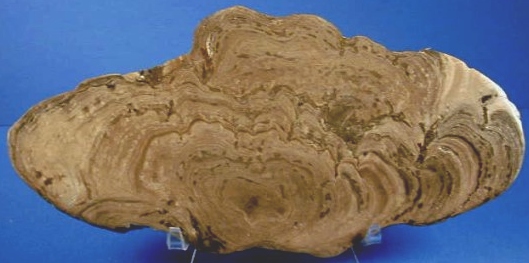
|
| Sliced Ordovician stromatolite, Wisconsin |
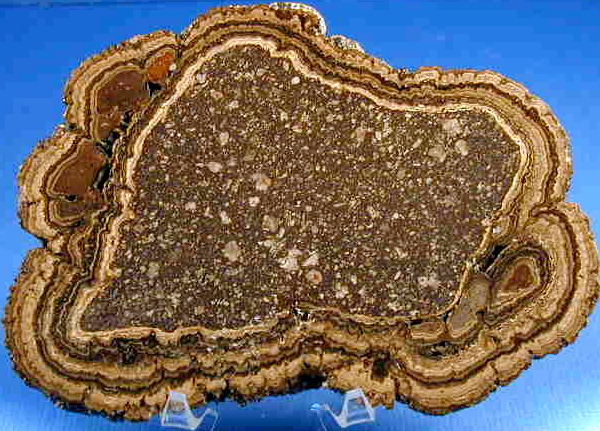
|
| Sliced Cretaceous stromatolite, Mexico
Fig. 14. Stromatolites are slow-growing, laminated algal mats. |
In several places Brown argues that there is no evidence for "speciation" (the origin of new species), even though there is strong empirical evidence for it in the fossil record, in the wild, and in the lab (Boxhorn, 2005; Callaghan, 1987; Darwin Was Right, 2015; Understanding Evolution, 2008). Even other creationists acknowledge that speciation has occurred (CMI, 2015), though most claim it has limits. Brown's denial of speciation seems to conflict even with other statements in his own book. For example, when discussing the capacity of the ark, he suggests that every species of land animal need not be taken aboard, since the Genesis "kinds" could represent broader taxonomic categories such as genera or families. He argues that these could rapidly diversify after the Flood into the species we see today--tacitly admitting that speciation must have taken place (as if he wants it both ways). Like many creationists, Brown insists that any changes in organisms never involve "new information," but merely reshuffling of existing genes. However, this is demonstrably false, since there are far more genetic alleles (variations of a gene) for many traits among humans today than could have existed in the few individuals aboard the ark. A similar argument can be made for many plants and animals as well (Kuban, 2015). Clearly the development of new alleles (which involve gene duplication, cross-overs, etc., combined with natural selection) constitutes new genetic information by any reasonable definition. Moreover, the "kinds" on the Ark were broader than a species, then even more alleles would have to evolve since the Flood. Ironically, in view of this, in order to account for all the variation we see among organisms today, YECs would need more rapid and dramatic evolution than even mainstream scientists allow.
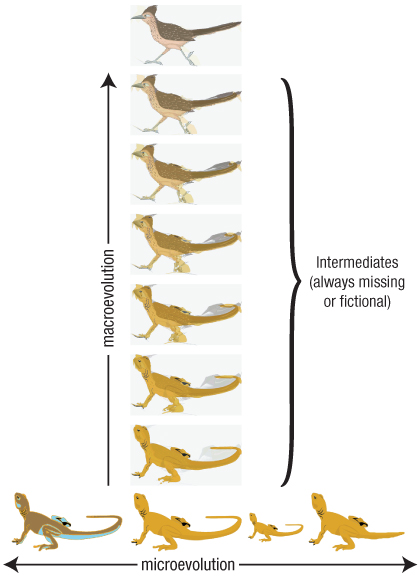
Fig. 15. Diagram from Brown's book (8th edition, Fig. 4) |
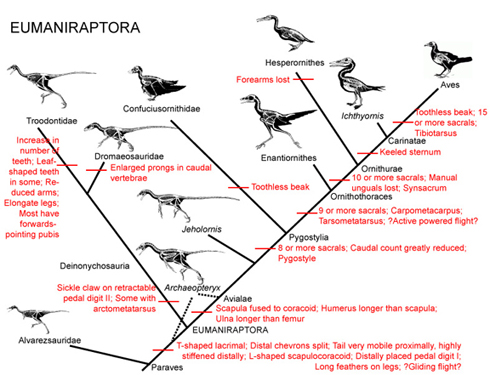
Fig. 16. More realistic view of bird evolution, based on fossil evidence. |
On page 6 Brown presents a simplistic diagram (Fig. 15) supposedly contrasting a critical difference between horizontal "microevolution" involving minor changes, and vertical "macroevolution", but the diagram is misleading in a number of ways. It fosters the idea that the former has nothing to do with the latter, whereas evolution has been shown to involve the accumulation of small changes (microevolution) into larger changes over time (macroevolution). It also falsely suggests that scientists believe roadrunners evolved from a four-legged, iguana-like lizard, and that evolution occurs in a linear or ladder-like fashion, both of which are false. As supported by extensive fossil and DNA evidence, evolution typically occurs in branching or bush-like patterns, and most paleontologists hold that birds descended from a branch of theropods (two-legged, carnivorous dinosaurs) (Fig. 16). Brown states that if bird really evolved from reptiles, intermediates would be found but "never are." However as discussed earlier, he unfairly dismisses a classic example (Archaeopteryx) by falsely depicting it as a "fraud". Moreover, many other fossils have been found with intermediate features between theropods and modern birds, blurring the distinction between them. In fact, most paleontologists today not only regard birds as descendants of dinosaurs, but a proper group of feathered dinosaurs. Questions about which specific fossils are in the direct line to modern birds and thus strictly "transitional" takes nothing away from the fact that many show features of both modern birds and earlier theropods, and occur at expected geologic horizons, and therefore are still intermediate forms, and valid evidence for evolution.
Brown's misunderstandings about evolution are further illustrated when he suggests that there was an unexplained "giant leap" from placental mammals to marsupial mammals . Biologists and paleontologists do not hold that placental mammals evolved into marsupials, nor even the other way around, but that both shared a common ancestor, as fossil evidence supports.
Speaking of marsupials, Brown does not address the serious question of how to explain the survival and current distribution of various land animals if they all debarked from the same location on or near Mt. Ararat only a few thousand years ago. For example, the vast majority of marsupial mammals are endemic to Australia and surrounding islands. How they managed to travel from the Ark to their current home, requiring a trek of thousands of miles in foreign and hostile environments without their normal food or habitat, and even cross an ocean, while virtually no marsupial mammals did, Brown does not explain. The problem is especially severe for animals such as the flightless Kiwi, the blind marsupial mole (which lives only in sand), or the sugar glider (a gliding marsupial superficially resembling flying squirrels, which lives in trees), Koalas (slow-moving, tree-dwellers which subsist mainly on Eucalyptus leaves--and only certain species at certain times of year (Adams, 2014)), or the Duckbilled Platypus (adapted to small creeks). Ironically, Brown shows a photo of a platypus and notes that it is found only in Tasmania and Australia, and it is "perfectly designed for its environment", seemingly unaware of the problem this creates for his Flood scenario (during the ark voyage, or afterward). The mainstream explanation for the concentration of marsupials in Australia is that about 50 million years ago, when early placentals evidently died out in Australia, marsupials there evolved and diversified extensively, since the continent had by then become isolated due to continental drift. For further discussion of the problem of animal distributions in YEC models, see Kuban (2014b).
At times Brown seems to take unfounded liberties even with Biblical references. For example, in arguing that a passage about Behemoth in the book of Job refers to a sauropod dinosaur, Brown states: "Behemoth had a 'tail like a cedar.' Any animal with a tail as huge and strong as a cedar tree is probably a dinosaur." However, the verse in question (Job 40: 17) says nothing about the size of the animal's tail, just its movement. Also, the Hebrew word often translated as "tail" can also refer to other animal appendages, including an elephant's trunk. Moreover, when the entire passage (Job 40: 15-24) is studied carefully, the dinosaur interpretation appears less likely than other alternatives (Kuban, 2008).
Another problem is that Brown lists references for each section by number, and when checking a reference, one often finds additional comments and quotations under it, but with only an author and page number attached (no date, title, volume and number, etc.), even though the full reference is not found anywhere within the section. Since nowhere in his book are references listed by author, this often makes finding the full references in these cases unnecessarily tedious and time-consuming. Ironically, Brown states that his book is in the "ideal format".
In his book section entitled "Earth Sciences" Brown's first curiously placed topic is: "Noah's Ark Probably Exists" He notes that he will cover "the more credible" Ark sightings, but then states that "some are probably mistaken." Indeed, the various accounts often disagree on basic details such as which mountain, or what level or side of the mountain, the Ark rests on. One of the accounts relates that a Russian pilot in World War I (1916) saw the Ark while flying over it. This supposedly led to two expeditions by soldiers who explored the boat, but could not report to the Czar before the Russian Revolution began. Brown acknowledges that the account contains "a few fictional elements" but neglects to mention that the story was first published in a German newspaper on April 1, 1933, and it is widely regarded as an April Fool's Day joke (Moore, 1989a). Brown devotes an entire page to describing the "CIA's 'Ararat Anomaly'" and even shows color drawings of what the ark "could look like" at the site, only to conclude that it is "probably not the Ark." Similar problems exist with the other sightings he relates, and none include any convincing, extant photographs. Even AIG author Tim Chaffey believes it unlikely that an Ark would survive into modern times on Mr. Ararat or nearby mountains due to the major earthquakes and other geologic activity in the area during the last several centuries (Chaffey, 2016).
More recently ICR's Tim Clarey, has argued that the Ark probably landed on a mountain ridge west of Mr. Ararat, undermining all previous "ark" reports by ICR's own John Morris and others often suggesting that it was somewhere on Mr Ararat. However, like the others, Clarey provides no compelling evidence of the Ark existing at any location (Clarey, 2019). In view of all this, one must wonder by what criteria Brown considers any such accounts "credible" or how they lead to the conclusion that the Ark "probably exists."
Taking all the above into consideration, and the fact that species would need to be taken for genetic reasons, Moore (1983) estimates that over 3,800,000 animals would have to be aboard the Ark. For a vessel approx. 450 x 75 x 45 feet = 1,518,750 cubic feet, that leaves less than 1/3 cubic foot per animal, not even counting food, aisles, humans and their quarters, etc., which seems quite problematic. However, even if we grant Brown the 16,000 figure, it still leaves a serious problem in terms of the care and feeding of so many different animals (many of which require fresh meat or live prey, specific types of plants, or other narrow diets, and which collectively would generate unimaginable amounts of waste every day (Isaac, 1998; Morton, 2003). Indeed, a zoo with far smaller and less diverse population would require a staff many times larger, even if all the humans and animals were healthy, which brings us to the next issue...
|
Brown claims that his model requires no miracles, but as noted earlier, when discussing the start of the Flood Brown implies that miracles either took place or may well have. In an early summary of his model entitled "What Initiated the Flood?" Brown began by stating, "Sometime after the Fall but before the Flood, God set in motion a chain of physical events that produced a global Flood" (Brown, 2003). On page 3 of his book he quotes a Bible verse stating that at God's rebuke the waters "fled", "the mountains rose," and "the valleys sank down," which also implies miracles. Miracles also seem to be implied in other aspects of Brown's model, and any other YEC Flood model; how else, for example, would two of every kind of land animal on earth know that they needed to migrate to the ark, and exactly where and when to go? (the poor tortoises, sloths, and land snails would have had to have a big head start). Although Brown seems not to realize it, his model would also require miracles in order for the Ark passengers and other life forms to have survived the multiple sources of lethal heat, radiation, and violence inherent in it (summarized in the Table at right). As discussed by Moore (1983), many other aspects of the Genesis account of Noah's ark and the Flood seem highly untenable (such as the construction of the ark, care of the animals, the disease/parasite problem noted earlier, etc.) unless still other miracles were involved. Brown also implies in several places that the Sun, Moon, planets, and all basic "kinds" of life were supernaturally created during a literal creation week only a few thousand years ago, hence more miracles. Brown is welcome to believe in all the miracles he likes, but to suggest his model doesn't involve any just doesn't hold water.

| 
|
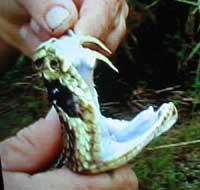
| 
|

| 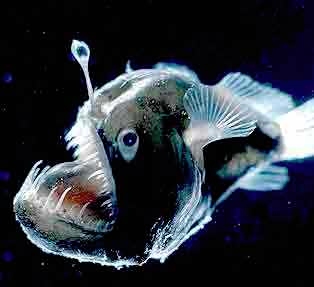
|
| Obligatory predators: Great White shark, scorpion, rattlesnake, Black Widow spider, Lion Jellyfish, Angler fish | |

| 
|

| 
|
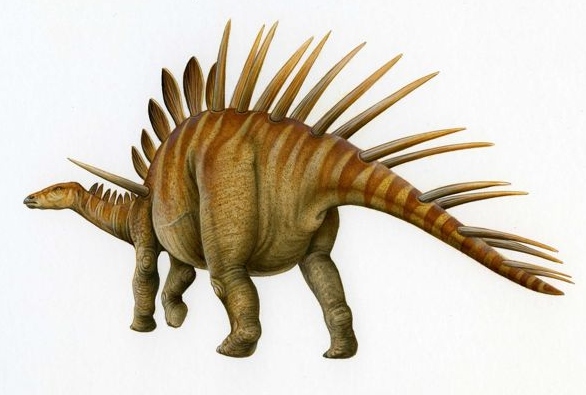
| 
|
| Animals with elaborate defenses against predators: Leaf insect, walking stick, porcupine, puffer fish, Kentrosaurus, Bombardier Beetle | |
Like many YECs, Brown argues that there was no physical death before the Fall4, which creates both theological and scientific problems (Kuban, 2013). Indeed, while a spiritual meaning of "death" in Genesis is required for Biblical coherency and consistency, insisting that it also means physical death there creates a serious problem, namely that if creatures obeyed the command to be "fruitful and multiply," without any check on reproduction rates, the "very good" creation would soon become a veritable hell on Earth, as populations exploded into absurd levels in a matter of days (considering the reproductive rates of many microbes and invertebrates). Even if one limited the lack of physical death to higher animals or humans, it would only postpone and not solve the problem.3 Moreover, the doctrine leaves unexplained the existence of obvious obligatory predators such as sharks, spiders, scorpions, and deep sea-angler fish (which have huge, needle-like teeth and wriggle worm-like "lures" on their heads to entice prey). Likewise, many animals such as porcupines, skunks, pufferfish (which are poisonous and can inflate their spine-covered bodies), and insects that look like sticks or leaves, have elaborate defense structures and mechanisms, which make no sense if there were no predators to defend against. Brown argues that the hot chemical spray of Bombardier beetles is evidence of design and fiat creation, apparently without noticing the discrepancy with the no-physical-death doctrine. Even more curious, on page 389 Brown suggests that predators may not have existed until after the Flood; but elsewhere he mentions larger fish fossilized with smaller fish in their mouths or stomachs.
Brown's 9th edition draft (Brown, 2016) includes a new section criticizing AIG and ICR authors for criticizing his model, especially on the topics of moon dust, frozen mammoth and Archaeopteryx. Ironically, these are subjects on which Brown makes some of his most demonstrably false claims, which often directly contradict the physical evidence. He implies they have not sufficiently researched these issues, which is ironic, since their articles on at least the first two subjects have typically been far more detailed and well-referenced than Brown's claims.
2. Even Biblical scholars debate whether the Bible verses about "clean animals" going into the Ark by "sevens" mean seven pairs or seven individuals for each clean animal (Thompson and Major (1987). There is also some controversy about why Gen. 6:19-22 appears to indicate that all animals were taken by "twos" (including birds), whereas Gen. 7:2-3 indicates that clean animals should be taken by sevens, with birds again specifically included.
3. If each human couple had only 2 children, with each generation being 20 years, then without physical death, the population would double every 20 years. In just 50 generations (1000 years) there would be over 1,125 trillion people on earth. To grasp the enormity and absurdity of this figure, realize that the entire earth's surface has only about 510 trillion square meters (about 600 trillion square yards)--including the oceans. In a few more generations, there would be more people than the number of square feet on earth, and a few more generations, more people than square inches on earth, which obviously is impossible. One could propose even lower reproduction rates, but that would not solve the problem, only prolong it.
4. In Christian theology, the "Fall" refers to the first sins committed by Adam and Eve in the Garden of Eden, as related in Genesis 3, in disobedience to God's command to not eat the fruit of the Tree of Knowledge of Good and Evil. This doctrine is closely tied to the concept of "original sin", as held by many denominations, whereby all subsequent humans inherited a "sinful nature." Because God told Adam that the day he ate of the fruit he would die, and other verses indicate that "death" entered the world at this time, many Christians believe that this means humans and other creatures were created as immortal beings, without physical death. However, besides the ecological and population problems this would create, and the need for the word to at least mean spiritual death in order to be consistent with other parts of the Bible, that physical death was not the main meaning, if any meaning, seems indicated by the fact that Adam did not die that same literal day, but according to the Bible, he lived for many years afterward. Of course, many Christians take parts or all of the Genesis account allegorically, and accept the scientific evidence that humans evolved from earlier primates, often believing that God directed or had a transcendent role in the process.
Aardsma, Gerald E., 1988b, "Has the speed of light decayed recently?," Creation Research Society Quarterly 25(1): 36f.
Adams, Martha, 2014. Why Do Koalas Live Only in Australia? Web article at: http://www.brighthub.com/environment/science-environmental/articles/128429.aspx?cid=parsely_rec
AIG, 2008. Anonymous article at Answers in Genesis Website, at: http://www.answersingenesis.org/articles/wog/white-cliffs-dover
Arthur, Joyce, 1995. A Few Silly Flaws In Walter Brown's Hydroplate Theory. Website article at: http://mypage.direct.ca/w/writer/hydro.html. Note: Brown had made a number of modifications to his theory since Joyce's article, but many of her criticisms are still valid. 2015 Note: Joyce's article no longer appears at the above site, but can be accessed at the following archive: https://web.archive.org/web/20150429164640/http://mypage.direct.ca/w/writer/hydro.html
Babinski, Edward T, 2015. Whale Evolution: Introduction to The Evolution of Cetaceans (Whales, Dolphins, Porpoises). Web site at: http://etb-whales.blogspot.com/2012/03/whale-evolution-introduction-to.html
Bahcall, John N., 2004. Solving the Mystery of the Missing Neutrinos. Web article at: http://www.nobelprize.org/nobel_prizes/physics/articles/bahcall/index.html
Batten, Don, Ken Ham, Jonathan Sarfati, and Carl Wieland, 2006. Where are all the Human Fossils? Creation Magazine, Dec 91-Feb 92, Vol. 14, No. 1, pp. 28-33. Web version at: http://www.christiananswers.net/q-aig/aig-c014.html Note, Oddly, this page does not list the authors; however, previously this article was found at www.answersingenesis.org/docs2/4419.aspa with authors listed. Now the URL redirects to the Snelling (1991) article.
Behe, Michael, 1996. Darwin's Black Box. New York: The Free Press.
Boule, Marcellin, and Henri V. Vallois, Fossil Men (New York: The Dryden Press, 1957), p. 145.
Boxhorn, Joseph, 2005. Observed Instances of Speciation. TalkOrigins web article at: http://www.talkorigins.org/faqs/faq-speciation.html
Brown, Walter T., 1986. The Fountains of the Deep, Proceedings of the First International Conference on Creationism (Pittsburgh: Creation Science Fellowship, 1986), p. 23-38.
Brown, Walter T., 2003. What Triggered the Flood? Creation Research Society Quarterly, 40 (2), pp. 65-70.
Brown, Walter T., 2008. In the Beginning: Compelling Evidence for Creation and the Flood, 8th Edition. Website with 8th edition order form and 9th edition draft at: http://www.creationscience.com/onlinebook/index.html
Brown, Walter T. 2016. In the Beginning: Compelling Evidence for Creation and the Flood, 9th Edition draft at: http://rsr.org/files/docs/9th-edition.pdf
Bushnell, David I, Jr. 1913, Petroglyphs Representing the Imprint of the Human Foot. American Anthropologist, Vol. 15, No. 1, p. 8-15. Web version available at: http://www.jstor.org/stable/i227195
Callaghan, Catherine A. 1987. Instances of observed speciation. The American Biology Teacher, 49 (2), pp. 34-36 Web abstract at: http://www.jstor.org/stable/4448413?seq=1#page_scan_tab_contents
Carpenter, Kenneth, 1999. Eggs, Nests, and Baby Dinosaurs: A Look at Dinosaur Reproduction, Indiana University Press.
Castagnoli, Geno, 2009. Email communications. Castagnoli described many ways in which Brown repeatedly threw up road blocks and unfair terms to avoid a debate.
Catalano, John, 2004. Publish or Perish: Some Published works on Biochemical Evolution. TalkOrigins web article at: http://www.talkorigins.org/faqs/behe/publish.html
Chadwick, A. V., 1973. Grand Canyon palynology -- a reply. Creation Research Society Quarterly 9: 238.
Chadwick, Arthur V., 1981. "Precambrian Pollen in the Grand Canyon, a Reexamination." Geoscience Research Institute, Origins 8(1):7-12 (1981)
Chaffey, Tim, 2016. Has the Ark Been Found? AIG web article at: https://answersingenesis.org/noahs-ark/noahs-ark-found/has-ark-been-found/
Chiappe, Luis M. and Lowell Dingus, 2001. Walking on Eggs: The Astonishing Discovery of Thousands of Dinosaur Eggs in the Badlands of Patagonia, Scribner, New York.
Charig, Alan et al., 1986. Archaeopteryx is not a forgery. Science 232: 622-625.
Clarey, Tim, 2019. The Ark Landed West of Mt. Ararat. Acts and Facts, July 2019, Vo. 48, No. 7.
CMI (Creation Ministries International), 2015. Anonymous article at CREATION.COM website: Arguments we think creationists should NOT use. http://creation.com/arguments-we-think-creationists-should-not-use
Conrad, 1982. Creation/Evolution Journal, Issue 8 (Spring 1982), "Are There Human Fossils in the "Wrong Place" for Evolution?" http://ncse.com/cej/3/2/are-there-human-fossils-wrong-place-evolution
Dunkelberg, Pete, 2003. Irreducible Complexity Demystified. Talk Origins web article at: http://www.talkdesign.org/faqs/icdmyst/ICDmyst.html
Daeschler, E.B., N. H. Shubin and F.A. Jenkins, 2006. A Devonian tetrapod-like fish and the evolution of the tetrapod body plan. Nature 440: 757-763. For more references on this important find, see: https://bioweb.uwlax.edu/bio203/f2013/raabe_mic2/references.htm
Dalrymple, Brendt G., 1991. The Age of the Earth, Stanford, Stanford University Press.
Radiometric Dating Does Work! NCSE Reports. Vol. 20, Issue 3. pp. 14-19. Web version at: http://ncse.com/rncse/20/3/radiometric-dating-does-work
Dalrymple, Brendt G., 2006. How Old is the Earth: A Response to "Scientific" Creationism. Talk Origins web article at: http://www.talkorigins.org/faqs/dalrymple/radiometric_dating.html
Darwin Was Right, 2015. Evidence from Observed Speciation. Web article at: http://www.darwinwasright.org/observations_speciation.html
Day, Robert P. J. 1997. The Decay of c-decay. Talk Origins web article at: http://www.talkorigins.org/faqs/c-decay.html
Dutch, Steven, 2009. The Moon: South Pole-Aitken Basin, Web article at: https://www.uwgb.edu/dutchs/GeolColBk/MoonSPAitken.HTM
Ebert, Ronald. 1997. Reports of the National Center for Science Education, Vol. 17, No. 5.
Faulkner, Danny R. 2013. An Analysis of Astronomical Aspects of the Hydroplate Theory. Creation Research Society Quarterly, Vol. 49, No. 3, pp. 197-210. Web version at: https://www.creationresearch.org/index.php/extensions/crs-quarterly/s5-box/item/26-an-analysis-of-astronomical-aspects-of-the-hydroplate-theory
Farley, K. A. et al, 2013. In Situ Radiometric and Exposure Age Dating of the Martian Surface. Science, 343 (6169). Art. no. 1247166. See: http://authors.library.caltech.edu/42658/
Fleming, Jon, 2012. Postings at evcforum.net at: http://www.evcforum.net/dm.php?control=msg&t=16688
Foley, Jim, 2002. Fossil Hominids: Respond to In the Beginning. Talk-Origins article at: http://www.talkorigins.org/faqs/homs/wbrown.html
Foley, Jim, 2004. More on Walter Brown's debate offer. Talk-Origins archive article at: http://www.talkorigins.org/faqs/homs/wbrown2.html.
Foley, Jim, 2004b. Web article at: http://www.talkorigins.org/faqs/homs/a_anomaly.html
Foley, Jim, 2911. Prominent Hominid Fossils. Web article at: http://www.talkorigins.org/faqs/homs/specimen.html#neandertals
Fortey, Richard, 1999. Life: A Natural History of the First Four Billion Years of Life on Earth. Vintage. 400 pages.
Green, Stewart, 2015. "Geology of Mount Everest." Web article at: http://climbing.about.com/od/Mount-Everest/a/Geology-Of-Mount-Everest.htm
Gingerich, P. et al, 1990. "Hind Limbs of Eocene Basilosaurus: Evidence of Feet in Whales," Science 249, July 13, 1990, p. 154).
Gingerich et al, 1994. "New whale from the Eocene of Pakistan and the origin of cetacean swimming," Nature 368, April 28, 1994, pp. 844-847.
Gleick, P.H. Earth's water distribution. Water Science for Schools. U.S. Geological Survey. 28 August 2006. For more estimates of ocean volume, see: http://hypertextbook.com/facts/2001/SyedQadri.shtml.
Glickson, Andrew, 2013. Precambrian Asteroid Impacts, Chapter in: The Asteroid Impact Connection of Planetary Evolution, pp.67-89, Springer Netherlands. Web abstract at: http://link.springer.com/chapter/10.1007/978-94-007-6328-9_8
GRI, 2015. "Dinosaurs". Web article at:
Hastings, Ronnie J., 1987a. "Creation Physics" and the speed of light, Unpublished manuscript described in Strahler (1987), pp. 116-118.
Hastings, Ronnie J., 1987b. New Observations on Paluxy Tracks Confirm Their Dinosaurian Origin. Journal of Geological Education, Vol. 35, No. 1, pp. 4-15.
Hastings, Ronnie J., 1988, Rise and Fall of the Paluxy Man Tracks. Perspectives on Science and Christian Faith (Journal of the ASA), Vol. 40, No. 3, pp. 144-155.
Hazen, Robert M., 2013. The Story of Earth: The First 4.5 Billion Years, from Stardust to Living Planet. Penguin Books.
Henke, Kevin, 2010. Dr. Humphreys' Young-Earth Helium Diffusion "Dates": Numerous Fallacies Based on Bad Assumptions and Questionable Data. TalkOrigins web article at: http://www.talkorigins.org/faqs/helium/zircons.html
Hoyle, Fred, and Wickramasinghe, C., 1986. Archaeopteryx, the primordial bird: a case of fossil forgery, Christopher Davies, London.
Hurlbut, Terry, 2015, "Glen Kuban wrong on Walt Brown," Web article at: http://creationsciencehalloffame.org/2015/09/03/science/models/glen-kuban-wrong-on-walt-brown/
Isaac, Mark, 1989. Problems with a Global Flood. Second Edition. TalkOrigins web article at: http://www.talkorigins.org/faqs/faq-noahs-ark.html#fitting
Isaac, Mark, 2003. Claim CA341 (Index of Creationist Claims): Alleged Out of Place Pollen. Talk Origins website article at: http://www.talkorigins.org/indexcc/CC/CC341.html
Isaac, Mark, 2003. Claim CA342 (Index of Creationist Claims). Talk Origins website article at: http://www.talkorigins.org/indexcc/CA/CA342.html
Isaac, Mark, 2004. Claim CF210 (Index of Creationist Claims). Talk Origins website article at: http://www.talkorigins.org/indexcc/CF/CF210.html
Isaac, Mark, 2005. Claim CE110: Receding Moon. TalkOrigins website article at: http://www.talkorigins.org/indexcc/CE/CE110.html
Isaac, Randy, 2007. Assessing the RATE Project. Perspectives on Science & Christian Faith, June 2007, pp. 143-146. ASA website article at: http://www.asa3.org/ASA/education/origins/rate-ri.htm
Jellison, Gerard P., 2009a. Wrong and I Can Prove it. Amazon.com review of Walter Brown's book, found at:
http://www.amazon.com/Beginning-Compelling-Evidence-Creation-Flood/dp/1878026097
and at: http://paleo.cc/ce/wbrown-jellison-review.htm
Jellison, Gerard P., 2009b. Follow-up comments to Amazoon.com review of Walter Brown's book. Found within comments referenced in Jellison (2009a) above, or separately at: http://paleo.cc/ce/wbrown-jellison-comments-2014.htm
Jellison, Gerard P., 2009c. Personal communication and unpublished report "Radiometric Dating, Deep Time, and Creationism."
Jellison, Gerard P., 2009d. "Critique of Some New Setterfield Material," Web article at: http://crankastronomy.org/cdecay/SetterfieldAddenda2009.pdf
Jellison, Gerard P., and W.T. Bridgman, 2007. "Analysis of the Variable Lightspeed (c-Decay) Theory of Barry Setterfield." Web article at: http://crankastronomy.org/cdecay/cdecay_2007Jellison3.pdf Jennings, S. and G. R. Thompson, 1986. Diagensis of Plio-Pleistocene sediments of the Colorado River Delta, southern California. Journal of Sedimentary Petrology 56(1): 89-98.
Keary, Philip & Frederick J. Vine, 1996. Global Tectonics. Blackwell Science, 2nd ed.
Krot, Alexander N., 2002. Web article at: http://www.psrd.hawaii.edu/Sept02/isotopicAges.html
Krot, Amelin, Y., A. N., Hutcheon, I. D., and Ulyanov, A. A., 2002. Lead isotopic ages of chondrules and calcium-aluminum-rich inclusions. Science, vol. 297, p.1678-1683.
Kuban, Glen, 1986a. "The Taylor Site 'Man Tracks'," Origins Research, Vol. 9., No. 1, pp. 1-10. Web version at: http://paleo.cc/paluxy/tsite.htm
Kuban, Glen, 1986b. A summary of the Taylor site evidence. Creation/Evolution 6(1): 11-19. Web version at: http://www.ncseweb.org/resources/articles/5063_issue_17_volume_6_number_1__4_23_2003.asp
Kuban, Glen, 1989. Elongate Dinosaur Tracks, In: Gillette, David D. and Martin G. Lockley, eds., Dinosaur Tracks and Traces, 1989, Cambridge University Press, Cambridge, pp. 57-72. Web version at: http://paleo.cc/paluxy/elong.htm
Kuban, Glen, 1994. An Overview of Dinosaur Tracking. M.A.P.S. Digest, Mid-America Paleontology Society, Rock Island, IL. Web version at: http://paleo.cc/paluxy/ovrdino.htm
Kuban, Glen J, 1997. Sea-monster or Shark? An Analysis of a Supposed Plesiosaur Carcass Netted in 1977. Reports of the National Center for Science Education, May/June 1997, Vol. 17, No. 3, pp. 16-28. Web version at: http://paleo.cc/paluxy/plesios.htm
Kuban, Glen J, 2005. Alleged Human Tracks in Carboniferous Rocks of Kentucky. Web article at: http://paleo.cc/paluxy/berea-ky.htm
Kuban, Glen J, 2006a. Fossil Tracks and Other Trace Fossils Falsify Flood Geology. Web article at: http://paleo.cc/ce/tracefos.htm
Kuban, Glen, 2006b. Alleged Iron Pot in Coal. Web article at: http://paleo.cc/paluxy/ironpot.htm
Kuban, Glen J, 2007. "Do Human Tracks Occur in the Kayenta of Arizona?: A Review of a CRSQ Report on Alleged "Humanoid" Tracks in Arizona". Web article at: http://paleo.cc/paluxy/arizon.htm
Kuban, Glen J, 2008a. "A Russian Paluxy?", Web article at: http://paleo.cc/paluxy/russ.htm
Kuban, Glen J, 2008b. "Does the Bible Describe Dinosaurs in Job 40 and 41?", Web article at: http://paleo.cc/paluxy/behemoth.htm
Kuban, Glen J, 2011. "The 'Meister Print' An Alleged Human Sandal Print from Utah," Web article at: http://paleo.cc/paluxy/meister.htm
Kuban, Glen J, 2013. "No Physical Death Before the Fall?", Web article at: http://paleo.cc/ce/nodeath.htm
Kuban, Glen J, 2014a. "Diseases Refute Young-Earth 'Flood Geology'," Web article at: http://paleo.cc/ce/ark-disease.htm
Kuban, Glen J, 2014b. "Marsupial Distribution Refutes YECism," Web article at: http://paleo.cc/ce/marsupials.htm
Kuban, Glen J, 2015. Genetic Diversity Refutes Young Earth Creationism. Web article at: http://paleo.cc/ce/ark-gene.htm
Lie-Svendsen, O. and M. H. Rees, 1996. Helium escape from the terrestrial atmosphere - the ion outflow mechanism. Journal of Geophysical Research 101: 2435-2443.
Lindsay, 2009. "Polystrate" Fossils. Web article at: http://www.don-lindsay-archive.org/creation/polystrate.html
Lippard, Jim, 1989a. An Examination of the Research of Creationist Walter Brown. Creation/Evolution Journal, Fall 1989, Vol. 9, No, 1, pp. 23-25. Web version at http://ncse.com/cej/9/1/examination-research-creationist-walter-brown
Lippard, Jim, 1989b. A Further Examination of the Research of Creationist Walter Brown. Creation/Evolution Journal, Winter 1989, Vol. 9, No, 2, pp. 17-33. Web version at http://ncse.com/cej/9/2/further-examination-research-walter-brown
Lippard, Jim, 1990. A Final Response to Walter Brown. Creation/Evolution Journal, Vol. 10, No. 1 (Issue 27, Summer 1990), pp. 28-36. Web version at: http://ncse.com/cej/10/1/final-response-to-walter-brown
Lockley, Martin G., 2006, Email communication.
Lockley, M. G., Meyer, C. A., Schultz-Pittman, R., and Forney, G., 1996. Late Jurassic dinosaur tracksites from Central Asia: a preliminary report on the world's longest trackways. in Morales, M. (ed.) Continental Jurassic Symposium Volume. Museum of Northern Arizona p. 271-273
Lucas, Spencer G, and Andrew Heckert, 2011. Late Triassic Aetosaurs as the trackmaker of the tetrapod footprint ichnotaxon Brachychirotherium. Ichnos 18:4, pp. 197-208.
Lucas, Spencer G, Nicholas J.Minter, and Adrian P. Hunt, 2010. Re-evaluation of alleged bees'' nests from the Upper Triassic of Arizona. Palaeogeography Palaeoclimatology Palaeoecology, 286:194-201. Web version at: http://www.researchgate.net/publication/262372166_Re-evaluation_of_alleged_bees%27_nests_from_the_Upper_Triassic_of_Arizona
Matson, Dave. 2002. How Good are Those Creationist Arguments? Talk Origins archive article at: http://www.talkorigins.org/faqs/hovind/howgood-yea.html#proof1
Matson, Dave, 1995a. Young-earth "proof" #1: The sun is shrinking at 5 feet/hour which limits the earth-sun relationship to less than 5 million years. Web article at: http://www.infidels.org/library/modern/dave_matson/young-earth/specific_arguments/sun_shrinking.html.
Matson, Dave, 1995b. Young-earth "proof" #2: Given the rate at which cosmic dust accumulates, 4.5 billion years would have produced a layer on the moon much deeper than observed. By implication, the Eearth is also young. Web article at: http://infidels.org/library/modern/dave_matson/young-earth/specific_arguments/moon_dust.html
Matson, Dave, 1995c. Young-earth proof #4: "There are no fossil meteorites in the geologic record," Web article at: http://infidels.org/library/modern/dave_matson/young-earth/specific_arguments/meteor.html
Matson, Dave E. 1994. How Good Are Those Young-Earth Arguments? Talk Origins web article at: http://www.talkorigins.org/faqs/hovind/howgood-add.html#A6
Meert, Joe, 2002. Were Adam And Eve Toast? Web article at: http://gondwanaresearch.com/hp/adam.htm
Meert, Joe, 2006. Walt Brown's Pseudochallenge. Web article at: http://gondwanaresearch.com/hp/walt_brown.htm
Miller, Kenneth R, 1996. Creation/Evolution, Volume 16: pp, 36-40. Web version at: http://www.millerandlevine.com/km/evol/behe-review/index.html
Miller, Kenneth R, 1999. Finding Darwin's God: A Scientist's Search for Common Ground Between God and Evolution. Harper Collins, Chapter 5.
Miller, Kenneth R, 2003. "Answering the Biochemical Argument from Design," Web article at: http://www.millerandlevine.com/km/evol/design1/article.html
Moore, Robert, A, 1983. Creation/Evolution Journal, Issue 11 (Winter 1983). Web version at: http://ncse.com/cej/4/1/impossible-voyage-noahs-ark. Note: this publication has since been renamed "NCSE reports."
Morton, G. R., H. S. Slusher, R. C. Bartman and T. G. Barnes, 1983. Comments on the velocity of light. Creation Research Society Quarterly 20: 63-65.
Morton, Glenn, 1999. Foundation, Fall and Flood. DMD Publishing.
Morton, Glenn, 2001. The Geologic Column. Web article at: http://www.talkorigins.org/faqs/geocolumn/
Morton, Glenn, 2003a. Walter Brown's Hydroplate Model. Web article at: http://www.oldearth.org/walter_brown_hydroplate_theory.htm.
Morton, Glenn, 2003b. Burrows cause problems for the Flood. Web article at: http://wayback.archive.org/web/20120319194636/http://home.entouch.net/dmd/burrows.htm
Morton, Glenn, 2003c. Noah's Ark: A Feasibility Study (Review). TalkOrigins web article at:
Morton, Glenn, 2004. Wilcox Coals and the Floating Forest/VeggieMat Young-earth Theories. Web article at: http://wayback.archive.org/web/20120319194607/http://home.entouch.net/dmd/veggiematic.htm
Nedin, Chris, 1997. "On Archaeopteryx, Astronomers, and Forgery," TalkOrigins web article at: http://www.talkorigins.org/faqs/archaeopteryx/forgery.html
Nelson, 2012, "Deformation of Rock", Tulane University course on Physical Geology. Web site at: http://www.tulane.edu/~sanelson/eens1110/deform.htm
Neyman, Greg, 2015 (downloaded). Young Earth Creation SCience Argument Index #G331: The Mouth of the Colorado River does not have enough sediment for the Grand Canyon. Web article at: http://www.oldearth.org/argument/G331_creation_science.htm
Norman, Trevor G. and Barry Setterfield, 1987. The Atomic Constants, Light, and Time. Flinders University of South Australia, School of Mathematical Sciences, Technical Report. Web version at: http://setterfield.org/report/report.html
Oard, Michael J., 2004. : Chapter 5: "Were Siberian Mammoths Quick Frozen?". Web version at: https://answersingenesis.org/answers/books/frozen-in-time/were-siberian-mammoths-quick-frozen/
Oard, Michael J., 2013. Analysis of Walt Brown's Flood model. Creation.com web article at: http://creation.com/hydroplate-theory
Parker, Joseph and David A. Grimaldi, 2014. "Specialized Myrmecophily at the Ecological Dawn of Modern Ants", Current Biology, Volume 24, Issue 20, pp. 2428-2434. Web abstract at: http://www.sciencedirect.com/science/article/pii/S0960982214011427
Perrin W. P., B. W. Würsig, and J. G. M. Thewissen (editors). 2009 (2nd Edition). Encyclopedia of Marine Mammals. Academic Press, Elsevier.
Plotner, Tammy, 2011. "Did Asteroid Baptistina Kill the Dinosaurs? Think other WISE..." Universe Today.
RationalWiki. 2012. Evidence against a recent creation. Web article at: http://rationalwiki.org/wiki/Evidence_against_a_recent_creation
RationalWiki, 2015. Transitional forms. Web article at: http://rationalwiki.org/wiki/List_of_transitional_forms
RationalWIki, 2018, "In the Beginning: Compelling Evidence for Creation and the Flood", Review at: https://rationalwiki.org/wiki/In_the_Beginning:_Compelling_Evidence_for_Creation_and_the_Flood
Ricklefs, Robert, 1993. The Economy of Nature, W. H. Freeman, New York.
Robinson, Keith, 1996. "Darwin's Black Box: Irreducible Complexity or Irreproducible Irreducibility?" TalkOrigins web article at: http://www.talkorigins.org/faqs/behe/review.html
Sarfati, Jonathan, 2002. Arguments We Think Creationists Should Not Use. Creation Ministries International (CMI) web article at: http://creation.com/arguments-we-think-creationists-should-not-use
Sakai et al, 2005. "Geology of the summit limestone of Mount Qomolangma (Everest) and cooling history of the Yellow Band under the Qomolangma detachment." The Island Arc 14: 4 pp. 297-310.
Setterfield, Barry, 1981, The velocity of light and the age of the universe: Ex Nihilo, vol. 4, no. 1, p. 38-48.
Setterfield, Barry, 1982, The velocity of light and the age of the universe: Ex Nihilo, vol. 1, no. 1 (International Edition), p. 53-93.
Setterfield, Barry, 1983, The velocity of light and the age of the universe: Ex Nihilo, vol. 1, no. 3 (International Edition), p. 41-46.
Sharp, Christopher, 2005. Walt Brown's Hydroplate Theory. Website essay at: http://www.csharp.com/hydroplate.html
Sheperd, Roy, 2012. Discovering Fossils: Introducing the Paleontology of Great Britain. Website at: http://www.discoveringfossils.co.uk/dover_kent_fossils.htm
Simmons, Bowen, 1997. Evolutionary Predictions. Article in TalkOrigins archive at: http://www.talkorigins.org/origins/postmonth/jan97.html
Snelling, Andrew A., 1991. Where Are All the Human Fossils?, Creation 14 (1):28-33, December 1991. Web version at: https://answersingenesis.org/fossils/fossil-record/where-are-all-the-human-fossils/
Snelling, Andrew A. and David E. Rush, 1993. "Moon Dust and the Age of the Solar System." Creation Ex-Nihilo Technical Journal Vol. 7, Part 1, pp. 2-42. Web version at: http://static.icr.org/i/pdf/technical/Moon-Dust-and-the-Age-of-the-Solar-System.pdf
Strahler, Arthur, 1987. Science and Earth History. Prometheus Books.
Sykes, G., 1937. The Colorado River Delta. American Geographical Society Special Publication 19, New York: American Geographical Society.
Tang, S. M. and Zhang, S. N., 2005. "Critical Examinations of QSO Redshift Periodicities and Associations with Galaxies in Sloan Digital Sky Survey Data". Astrophysical Journal 633 (1): 41.
Thewissen, J. G. M. (editor), 1998. The Emergence of Whales, Evolutionary Patterns in the Origin of Cetacea. Plenum Press, 475 pp. For many other references on whale evolution see: Research publications by Hans Thewissen and associates
Thewissen, J. G. M. (Hanns), 2014. The Walking Whales: From Land to Water in Eight Million Years, University of California Press, 256 pages.
Thompson, Bert, and Trevor Majo, 1986. How Many Clean Animals Did Noah Take into the Ark: Seven or Fourteen? Web article at: http://www.apologeticspress.org/APContent.aspx?category=11&article=1150
Thompson, Tim, 1996. Meteorite Dust and the Age of the Earth. TalkOrigins.org web article at: http://www.talkorigins.org/faqs/moon-dust.html
Thompson, Tim. 1997. On Walter Brown & Plate Tectonics. TalkOrigins wWeb article at: http://www.infidels.org/library/modern/tim_thompson/brown.html
Thompson, Tim. 2000. "The Recession of the Moon and the Age of the Earth-Moon System." TalkOrigins web article at: http://www.talkorigins.org/faqs/moonrec.html
William G. Tifft, William G., 1991. "Properties of the Redshift," The Astrophysical Journal, Vol. 382, pp. 396-415.
Understanding Evolution. 2015. University of California Museum of Paleontology. 22 August 2008
USGS, 2009. Age of the Earth. Web article at: http://pubs.usgs.gov/gip/geotime/age.html
Van Till, Howard. 1986. The Legend of the Shrinking Sun- A Case Study Comparing Professional Science and "Creation Science" in Action. Perspectives on Science and Christian Faith, 38.3:164-174. Web version at: http://www.asa3.org/ASA/PSCF/1986/PSCF9-86VanTill.html
Vardiman, Larry, et al. 2005. Radioisotopes and the Age of the Earth: Results of a Young-Earth Creationist Research Initiative. Institute for Creation Research, El Cajon, California.
Weems, Robert E. 1992. A Re-evaluation of the taxonomy of the Newark Supergroup saurischian dinosaur tracks, using extensive statistical data from a recently exposed tracksite near Culpeper, VA. Virginia Division of Mineral Resources Publication 119, pp. 113-127.
Weems, Robert E. 1993. Upper Triassic Reptile Footprints and a Coelacanth fish scale from the Culpeper Basin, Virginia. Biological Society of Washington Proceedings 106, pp. 390-401.
Weishampel, David B. 1996. Dinosaurs of the East Coast. John Hopkins University Press, pp. 186-190.
Wieiland, Carl, 1994. Diseases on the Ark. Creation Technical Journal, Vol. 8, No. 1, pp. 16-18. Web version at: http://creation.com/diseases-on-the-ark
Wiens, Roger C., 2002. Radiometric Dating, A Christian Perspective, Science in Christian Perspective (Publicaion of the American Scientific Affiliation). Web version at: http://asa3.org/ASA/resources/Wiens.html
Wikipedia, 2015. List of Transitional Fossils. Web article at: https://en.wikipedia.org/wiki/List_of_transitional_fossils
Winker, C. D. and S. M. Kidwell, 1986. Paleocurrent evidence for lateral displacement of the Pliocene Colorado River Delta by the San Andreas fault system, southeastern California. Geology 14(9): 788-791.
Young, Davis A., and Ralph F. Stearley, 2008. Bible, Rocks and Time: Geological Evidence for the Age of the Earth. IVP Academic,501 pages.
Zhao, Dapeng et al, 1997. Depth Extent of the Lau Back-Arc Spreading Center and Its Relation to Subduction Processes. Science 278 (5336), pp. 254-257.